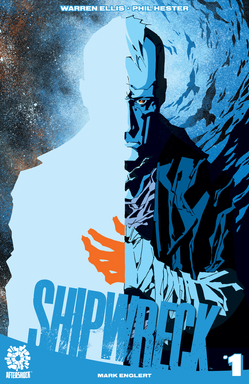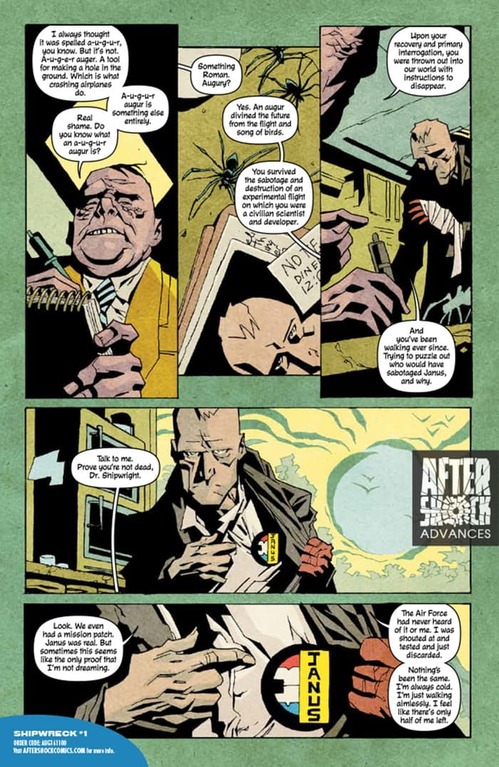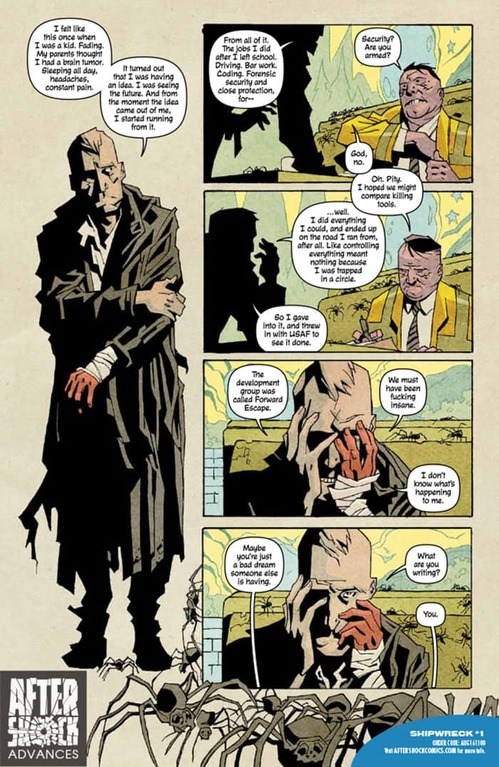Warren Ellis & Phil Hester’s Shipwreck #1 Doesn’t Sink
Main Art by Phil Hester & Mark Englert Comics Reviews Warren Ellis
Writer: Warren Ellis
Artist: Phil Hester
Colorist: Mark Englert
Publisher: AfterShock Comics
Release Date: October 5, 2016
 The last time Warren Ellis and Phil Hester worked together was for a short piece titled “The Operation” in 2002’s Oni Press Color Special, in which they introduced a team of paranormal investigators. Over a decade later, they’ve teamed up again for a tale of lost identities and strange landscapes. It’s a story that finds each of them playing to their strengths: Ellis’ comics are generally built around high concepts, and teem with brisk dialogue and strange ideas; Hester is equally capable of drawing thrilling pulp adventures (Green Arrow) and exploring much more surreal ground and characters (The Foot Soldiers). The first issue of Shipwreck features plenty of atmosphere and an abundance of mystery; it’s the sort of book in which the protagonist’s search for answers mirrors that of the reader.
The last time Warren Ellis and Phil Hester worked together was for a short piece titled “The Operation” in 2002’s Oni Press Color Special, in which they introduced a team of paranormal investigators. Over a decade later, they’ve teamed up again for a tale of lost identities and strange landscapes. It’s a story that finds each of them playing to their strengths: Ellis’ comics are generally built around high concepts, and teem with brisk dialogue and strange ideas; Hester is equally capable of drawing thrilling pulp adventures (Green Arrow) and exploring much more surreal ground and characters (The Foot Soldiers). The first issue of Shipwreck features plenty of atmosphere and an abundance of mystery; it’s the sort of book in which the protagonist’s search for answers mirrors that of the reader.
It begins with a man waking up on some rocks and walking into a town. A series of panels shows alternate glimpses of what he sees as the issue opens: in one, he’s looking at the sky; in another, he seems to be underwater; in still another, his body is being devoured by birds. They’re impossible to reconcile, and yet they’re all there—establishing the ambiguity at the heart of this particular story. The protagonist—Dr. Jonathan Shipwright—wanders into a diner, where an inspector is waiting for him. Their conversation alludes to a series of bizarre developments: an Air Force project gone wrong, a mysterious ability known as “augering” and still more ambiguity. “Maybe you’re just a bad dream someone is having,” the inspector says, and it seems as plausible an explanation as anything else at this point.

Shipwreck #1 Interior Art by Phil Hester & Mark Englert
There’s a moment towards the end of the issue that feels genuinely shocking: just as Ellis and Hester establish a rhythm—of Shipwright encountering eccentrics and having cryptic conversations with them, through which bits of his history and his reason for being there are revealed—they also demonstrate that the audience shouldn’t get too comfortable, that this template has plenty of room for nasty surprises along the way. Surprises as well as questions: who is Isham, the character Shipwright pursues? Who is the inspector working for? And what, exactly, is going on with the discoloration and strange proportions on one of Shipwright’s arms?

Shipwreck #1 Interior Art by Phil Hester & Mark Englert
While there’s plenty of dialogue when there is dialogue; the long wordless opening sequence immediately shows off the strength of Hester’s stylized artwork, cutting between first-person perspectives and the protagonist, scarred and lost in a surreal landscape. Hester’s command of body language is great to behold: a scene in which an offhand remark by Shipwright leads the inspector to reach for his weapon is brilliantly evocative through a series of small gestures. The coloring work of Mark Englert meshes neatly with Hester’s art to create a memorable sense of place—the scene set in the interior of the diner in particular has a neat blend of the quotidian and the psychedelic.

Shipwreck #1 Interior Art by Phil Hester & Mark Englert
Halfway through the issue, the inspector tells Shipwright about his practice of meticulously documenting everything. “My dream, you see, is that if everything ends, my own little continuum could be rebuilt, brick by brick, from my inspection of it,” he says. It’s a powerful moment, one that helps accentuate the layered storytelling at work in this issue. At this stage, Shipwreck abounds with the beginnings of mysteries, and it makes a compelling case for their fascinating power—and of the magnetism of the strange investigation which begins here.